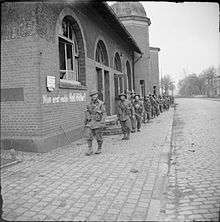160th Infantry Brigade and Headquarters Wales
| Welsh Border Brigade 160th (Welsh Border) Brigade 160th Infantry Brigade 160th (Wales) Brigade 160th Infantry Brigade and Headquarters Wales | |
|---|---|
 Current shoulder sleeve insignia of the 160th Infantry Brigade and Headquarters Wales. | |
| Active |
1908–1919 1920–1946–Present |
| Country |
|
| Branch |
|
| Type | Regular and Territorial Army |
| Size | Brigade |
| Part of |
53rd (Welsh) Infantry Division 1st (United Kingdom) Division |
| Garrison/HQ | The Barracks, Brecon, Wales |
| Battle honours |
World War I: * Gallipoli Campaign * First Battle of Gaza * Battle of Nablus (1918) World War II: * Battle of Normandy * Battle of Falaise * Battle of the Bulge * Battle of the Reichswald * Western Allied invasion of Germany |
| Commanders | |
| Notable commanders |
Sir John Dill Robert Knox Ross Eric Dorman-Smith Lashmer Whistler |
The 160th Infantry Brigade and Headquarters Wales or Brigâd 160 (Cymru) is a regional brigade of the British Army that has been in existence since 1908, and saw service during both World War I and World War II, as part of the 53rd (Welsh) Infantry Division. It is a regional command responsible for all of Wales. The brigade organises an annual patrolling competition in the Brecon Beacons, known as Exercise Cambrian Patrol.
Formation
The Welsh Border Brigade was originally raised in 1908, upon creation of the Territorial Force, and was part of the Welsh Division. The brigade was composed of the 1st, 2nd and 3rd Volunteer battalions of the Monmouthshire Regiment along with the 1st Battalion of the Herefordshire Regiment.
First World War
In 1915 the brigade was redesignated the 160th (1/1st South Wales) Brigade and the Welsh Division the 53rd (Welsh) Division. The brigade fought with the division in the Great War, in the Middle Eastern theatre.
The brigade was reconstituted as a result of British troops being sent to the Western Front during the emergency following the German March 1918 Spring Offensive.
Order of battle
- 1/1st Battalion, Monmouthshire Regiment (to February 1915)
- 1/2nd Battalion, Monmouthshire Regiment (to November 1914)
- 1/3rd Battalion, Monmouthshire Regiment (to February 1915)
- 1/1st Battalion, Herefordshire Regiment (to 24 April 1915)
- 2/4th Battalion, Queen's (Royal West Surrey Regiment) (from 24 April 1915 to 31 May 1918)
- 1/4th Battalion, Royal Sussex Regiment (from 24 April 1915 to 30 May 1918)
- 2/4th Battalion, Queen's Own (Royal West Kent Regiment) (from 24 April 1915 to 25 August 1918)
- 2/10th Battalion, Duke of Cambridge's Own (Middlesex Regiment) (from 24 April 1914 to 19 August 1918)
- 1/7th (Merioneth and Montgomery) Battalion, Royal Welsh Fusiliers (joined on 24 June 1918 from 158th (North Wales) Brigade)
- 160th Machine Gun Company, Machine Gun Corps (formed 11 May 1916, moved to 53rd Battalion, Machine Gun Corps 25 April 1918)
- 160th Trench Mortar Battery (formed 26 June 1917)
- 21st Punjabis (from 26 May 1918)
- 110th Mahratta Light Infantry (joined from Karachi on 28 June 1918, left for 20th Indian Brigade on 19 July)
- 1st Battalion, Cape Corps (South African, joined 22 July 1918)
- 17th Infantry (The Loyal Regiment) (from 6 August 1918)
Between the wars
After the war the brigade and division were disbanded as was the Territorial Force. However, both the brigade and division were reformed in 1920 in the Territorial Army. The brigade, now the 160th (South Wales) Infantry Brigade, was again composed of the same four battalions it had before the Great War. However, these were all posted to the 159th (Welsh Border) Infantry Brigade early in the 1920s and were replaced by the 4th, 5th, 6th and 7th Battalions of the Welch Regiment. The 6th and 7th Battalions were amalgamated as the 6th/7th Battalion, Welch Regiment and the 4th Battalion, King's Shropshire Light Infantry joined in the same year.
Second World War
The brigade, now composed of two battalions of the Welch Regiment and one of the Monmouthshire Regiment, together with the rest of the 53rd (Welsh) Division, was mobilised in late August 1939 and soon afterwards Britain declared war on Nazi Germany. In April 1940 the 160th Brigade was sent to Northern Ireland and, after the British Expeditionary Force (BEF) was evacuated from France, the brigade was mainly involved in anti-invasion duties and exercises training to repel a potential German invasion of Northern Ireland. The 160th Brigade, and the rest of the 53rd Division, were sent to Southeast England almost two years later, where they began training for the eventual Allied invasion of Northern France.

After another nearly two years spent in Kent training, the brigade, under the command of Brigadier Charles Coleman, with the rest of the 53rd Division, landed in Normandy as part of Operation Overlord (codename for the Allied invasion of Northwest Europe) in late June 1944,[1] and were almost immediately involved in severe attritional fighting around the French city of Caen, facing numerous German panzer divisions, in what came to be known as the Battle for Caen. The 160th Brigade later participated in the Second Battle of the Odon, sustaining heavy casualties, which resulted in the 1/5th Battalion, Welch Regiment being transferred to the 158th Brigade of the same division and replaced by the 6th Battalion, Royal Welch Fusiliers. The decision was made by the divisional commander, Major-General Robert Knox "Bobby" Ross (a former commander of the brigade), due to an acute shortage of infantrymen in the British Army at this stage of the war, even more so in finding sufficient numbers of battle casualty replacements (or reinforcements) for three battalions of the same regiment all serving together in the same brigade, which, like the 160th Brigade, had also suffered heavy losses. The brigade went on to fight in the Battle of Falaise, capturing large numbers of German troops as prisoners of war (POWs) and the subsequent Allied advance from Paris to the Rhine, later playing a minor role in the Battle of the Bulge, a large role in Operation Veritable in February 1945 and crossing the River Rhine into Germany over a month later, where it took part in the Western Allied invasion of Germany, finally ending the war in Hamburg, Germany.

The 160th Brigade remained in Germany on occupation duties until it was disbanded in late 1946.
Order of battle
The 160th Infantry Brigade was composed as follows during the war:[2]
- 4th Battalion, Welch Regiment
- 1/5th Battalion, Welch Regiment (left 3 August 1944)
- 2nd Battalion, Monmouthshire Regiment
- 160th Infantry Brigade Anti-Tank company (formed 1 July 1940, disbanded 15 February 1941)
- 6th Battalion, Royal Welch Fusiliers (from 4 August 1944)
Commanders
The following officers commanded the 160th Infantry Brigade during the war:[3]
- Brigadier A.E. Williams (until 10 May 1940)
- Brigadier R.K. Ross (from 10 May 1940 until 17 September 1942)
- Brigadier E.E. Dorman-Smith (from 17 September 1942 until 22 November 1943)
- Lieutenant Colonel C.F.C. Coleman (acting, from 22 November 1943 until 28 January 1944)
- Brigadier L.G. Whistler (from 28 January 1944 until 22 June 1944)
- Brigadier C.F.C. Coleman (from 22 June 1944 until 27 May 1945)
- Lieutenant Colonel H.B.D. Crozier (acting, from 27 May 1945 until 3 June 1945)
- Brigadier C.F.C. Coleman (from 3 June 1945)
Post war
After World War II the Territorial Army was reorganised as the TAVR. With the disbandment of 5th Division, the brigade came under the control of the new Support Command based in Aldershot, in April 2012.[4]
Current formation
Under the Army 2020 concept, 160th (Wales) Brigade was renamed as 160th Infantry Brigade and Headquarters Wales. It is one of the seven Adaptable Force brigades. It comprises:[5]
- 160th Infantry Brigade and Headquarters Wales in Brecon
References
- ↑ Joslen, p. 348
- ↑ Joslen, p. 348
- ↑ Joslen, p. 348
- ↑ House of Commons briefing note
- ↑ "Army 2020 Report" (PDF). Ministry of Defence. Retrieved 15 August 2015.
- ↑ The Rifles and The Royal Gloucestershire,Berkshire and Wiltshire Regiment Newsletter 2013 Archived 27 July 2013 at the Wayback Machine.
- ↑ Summary of Army 2020 Reserve Structure and Basing, page 24
- ↑ Army 2010 Update, page 9
Bibliography
- Falls, Cyril; A. F. Becke (maps) (1930). Military Operations Egypt & Palestine from June 1917 to the End of the War. Official History of the Great War Based on Official Documents by Direction of the Historical Section of the Committee of Imperial Defence. 2 Part II. London: HM Stationery Office. OCLC 256950972.
- Joslen, Lt-Col H.F. (2003) [1960]. Orders of Battle: Second World War, 1939–1945. Uckfield: Naval and Military Press. ISBN 978-1-84342-474-1.
External links
- 160 (Wales) Brigade – on British Army official website
- "Brigâd 160 (Cymru)". army.mod.uk. Archived from the original on 5 November 2013. (in Welsh)